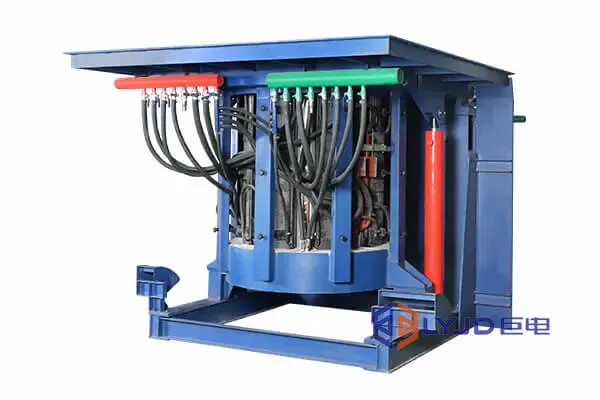Induction furnace
0 comments

Working principle
The heating principle of induction furnace is based on electromagnetic induction. When the current passes through the induction coil, it generates a changing magnetic field, which penetrates the metal material in the furnace and generates eddy currents in the metal. The eddy currents are converted into heat energy through the metal resistance, causing the metal to heat up. As the temperature of the metal increases, the intensity of the eddy currents also increases until the metal reaches the required melting temperature.
Type.
According to the different frequencies used, induction furnaces can be divided into the following categories
Medium frequency induction furnace: The frequency used is generally between 1 and 10 kHz. Suitable for medium melting capacity, widely used for melting cast iron, steel and other metals.
High frequency induction furnace: Uses a higher frequency, generally 10-100 kHz. Used for precision heating, suitable for smaller metal parts or metal materials that require high temperature treatment.
High frequency induction furnace: Also used for very small metal melting and very precise single metal heating.
Main advantages Main advantages Main advantages Main advantages
High efficiency and energy saving: Compared with traditional fuel furnaces, induction furnaces have high thermal efficiency, and the conversion efficiency from electrical energy to thermal energy exceeds 90%.
Fast heating speed: The heating speed of electromagnetic induction is very fast, which can make the metal reach the melting temperature quickly.
Accurate temperature control: By adjusting the current frequency and power, the heating temperature of the metal in the furnace can be accurately controlled to ensure stable product quality.
Reduce pollution: There is no direct contact between the furnace and the metal, thus avoiding the source of pollution.
Application field: Metal melting.
Metal melting: Induction furnaces are widely used in the foundry industry to melt metals such as aluminum alloys, copper alloys, and steel, especially for the manufacture of high-precision metal castings.
Heat treatment: Suitable for heat treatment processes such as metal quenching, annealing, and tempering.
Metal surface treatment: The metal surface can be hardened or surface modified by induction heating.
Casting: The molten metal is injected into the mold to produce various castings, especially those with complex shapes and high performance requirements.
Equipment composition
The induction furnace is mainly composed of the following components:
Induction coil: responsible for generating electromagnetic field, usually made of copper tube.
Power supply: provides the necessary high-frequency current to the induction coil. Common power supplies include transistors and rectifiers.
Furnace body: carries and protects the molten metal.
Cooling system: Since the electromagnetic field generates heat during induction heating, the furnace body and coil must be temperature-regulated by the cooling system to prevent overheating.
Control system: monitors and adjusts various parameters of the induction furnace, such as temperature, power and current, to ensure the stability and accuracy of the heating process.
Operation and maintenance: Easy operation.
Easy operation: The operation of the induction furnace is relatively simple, and the technician only needs to set the appropriate current and frequency for heating.
Maintenance required: Although the induction furnace equipment is more durable than the traditional furnace, it is still necessary to regularly check the coil, cooling system, etc. to ensure normal operation. In particular, the power supply unit may overheat or be damaged if used under high load for a long time.
Safety precautions.
High temperature: When operating the induction furnace, protective measures are required because the melting temperature of the metal is very high.
Electromagnetic field: Induction furnaces generate strong electromagnetic fields during operation, and appropriate protection measures must be taken to ensure that operators are not disturbed by electromagnetic interference.
Cooling system: The cooling system must be checked regularly to avoid overheating or failure of the equipment due to insufficient cooling.
If you are interested in a specific aspect or want to know more about the technical details and considerations of choosing different types of induction furnaces, please contact me further.
Comments